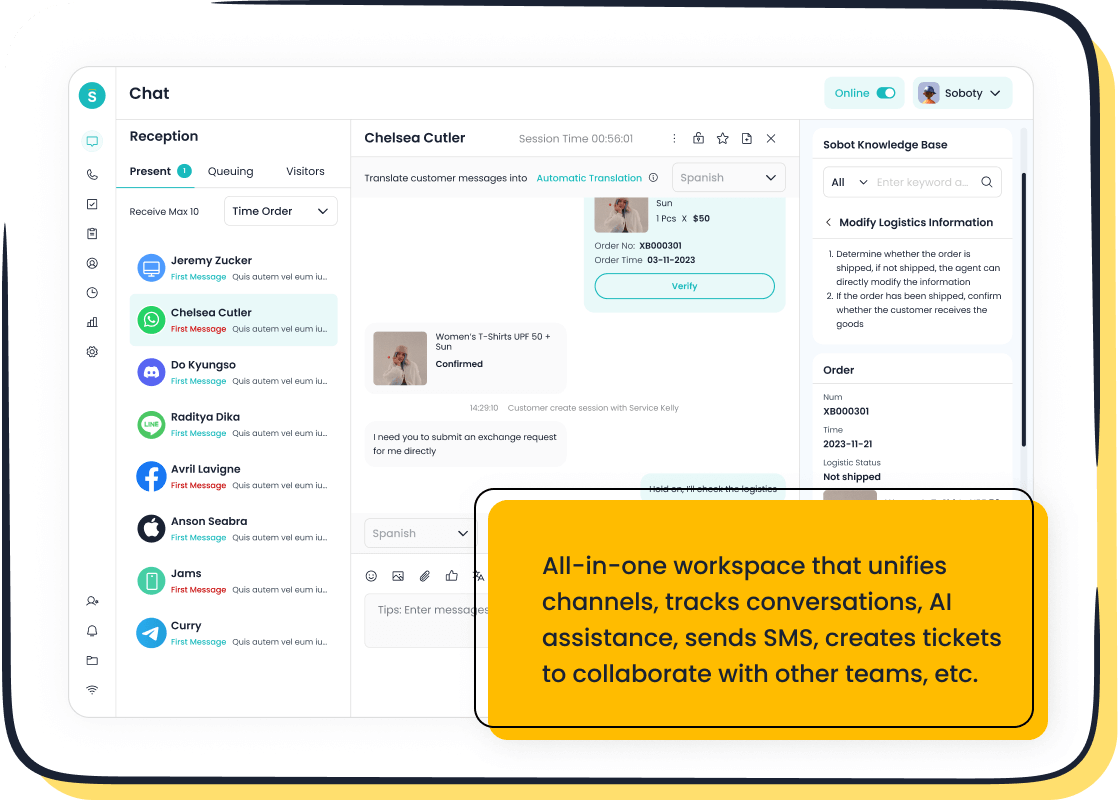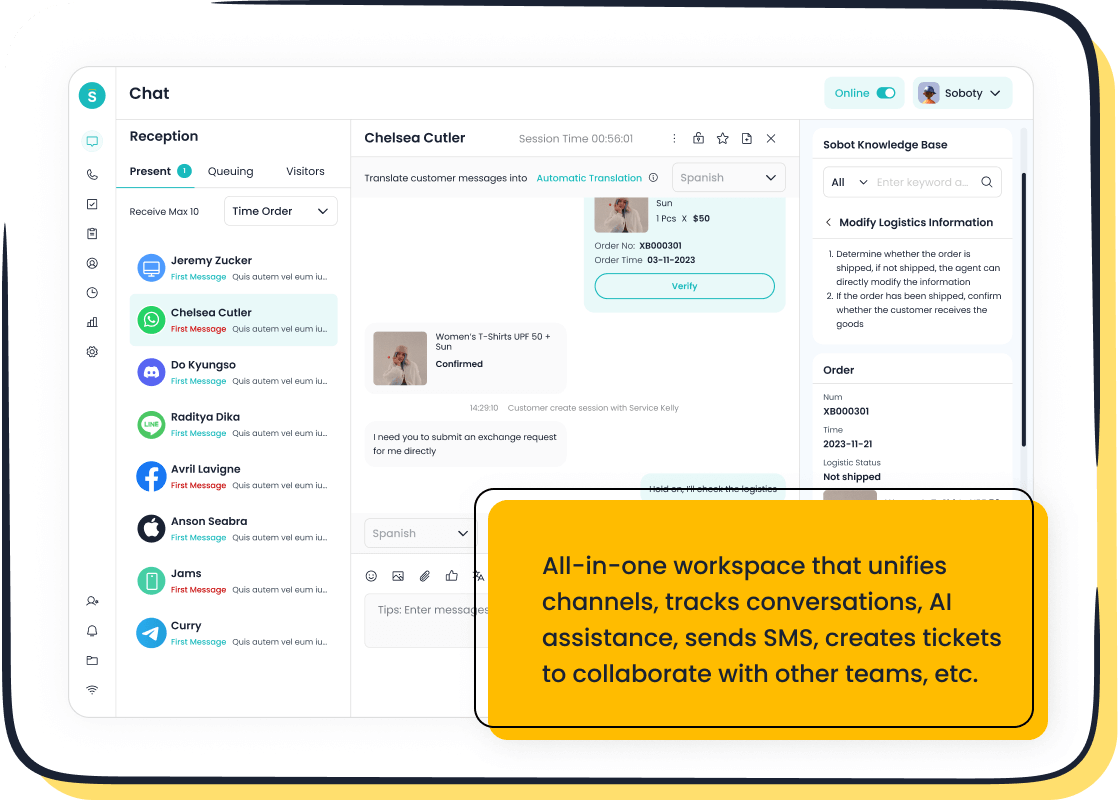Simple Tips for Better Customer Service Experiences

Great customer service isn’t just a nice-to-have—it’s a game-changer. Did you know loyal customers spend 67% more than new ones? Or that improving customer retention by just 5% can boost profits by up to 95%? Exceptional customer experiences build trust, drive customer loyalty, and spark meaningful customer engagement. By focusing on different kinds of customer service, you can create lasting relationships that benefit both your customers and your business. Brands like Sobot prove that prioritizing customer satisfaction leads to remarkable results.
Understand Different Kinds of Customer Service
Understanding the different kinds of customer service is essential for creating meaningful customer relationships. By focusing on empathy, personalization, and proactive support, you can meet customer expectations and build customer loyalty.
The Role of Empathy in Customer Interactions
Empathy is the heart of customer-centric approaches. When you show genuine care, customers feel valued and understood. For example, Daniel Kahneman, a renowned psychologist, highlights that humans are "feeling machines that think." This means emotions often drive decisions, including how customers perceive your service.
Simple phrases like, "I’m so sorry you had to deal with this," or "Thank you for bringing this to my attention," can make a big difference. Empathy helps resolve issues faster and strengthens customer relationships. In fact, 64% of U.S. consumers believe companies have lost the human touch, which negatively impacts retention. By prioritizing empathy, you can stand out and foster trust.
Personalizing the Customer Journey
Personalization is another key to exceeding customer expectations. When you tailor experiences to individual needs, customers feel special. Companies like Amazon and Netflix excel at this by using customer data to recommend products or content. This strategy drives engagement and boosts retention. Did you know 80% of customers prefer brands that offer personalized experiences? By adopting customer-centric approaches, you can improve retention by up to 56%.
Think about Starbucks. They personalize offers based on purchase history and location, which enhances customer loyalty. Small efforts like remembering a customer’s name or preferences can go a long way in creating a memorable customer experience.
Proactive Support Across Multiple Channels
Proactive support anticipates customer needs before they even ask. This approach not only reduces churn but also enhances satisfaction. For instance, Amazon monitors delivery issues and resolves them proactively, ensuring a seamless customer experience. Companies that adopt proactive strategies can reduce churn by 15% and increase customer lifetime value.
Offering support across multiple channels is equally important. Customers expect seamless transitions between platforms like email, chat, and social media. Meeting these expectations strengthens customer relationships and shows your commitment to customer-centricity.
Enhance Communication for Better Customer Experiences

Clear and effective communication is the backbone of any great customer experience. When you focus on how you communicate, you can better understand customer needs, resolve issues faster, and build stronger relationships.
Using Clear and Positive Language
The words you choose can make or break a conversation. Clear and positive language helps customers feel confident and valued. For example, instead of saying, "I can’t do that," try, "Here’s what I can do for you." This small shift creates a more welcoming tone.
Research shows that clear communication reduces uncertainty and encourages engagement. Take a look at these psychological effects:
| Psychological Effect | Description |
|---|---|
| Negativity Bias | Positive language helps focus on favorable experiences, reducing the impact of negative interactions. |
| Ambiguity Aversion | Clear language minimizes uncertainty, encouraging customers to engage rather than avoid options. |
| Framing Effect | Balanced messaging influences decisions by presenting information in a clear and positive manner. |
By using clear and positive language, you can turn even challenging situations into opportunities to enhance customer satisfaction.
Active Listening to Address Customer Needs
Listening isn’t just about hearing words; it’s about understanding what your customers truly need. When you actively listen, you show that their concerns matter. This builds trust and loyalty.
Did you know that 94% of customers who rate their experience as "very good" are likely to return for more? Active listening plays a huge role in achieving this. Simple actions like paraphrasing what the customer said or asking clarifying questions can make all the difference. For instance, saying, "Let me confirm, you’re looking for a solution to [specific issue], right?" shows you’re engaged and focused on their needs.

Leveraging Sobot Live Chat for Seamless Communication
When it comes to seamless communication, Sobot Live Chat is a game-changer. It allows you to connect with customers across multiple channels like websites, apps, and social media—all from one unified workspace. This ensures no message gets missed and every interaction feels personal.
The results speak for themselves. Businesses using Sobot Live Chat have seen a 20% reduction in inbound discussions and a 96% positive feedback rate. Here’s a quick snapshot of its performance metrics:

With features like AI-assisted tools, auto-translation, and satisfaction surveys, Sobot Live Chat helps you address customer needs efficiently while boosting satisfaction. It’s not just a tool—it’s a way to elevate your customer support strategy.
Leverage Customer Feedback to Drive Improvements
Collecting Feedback Through Surveys and Reviews
Gathering customer feedback is like opening a window into the minds of your customers. It helps you understand what they love, what frustrates them, and how you can improve. Surveys and reviews are excellent tools for this. You can use email, social media, or even in-app feedback to collect insights. Each method has its strengths. For example, email surveys feel familiar, while in-app feedback captures real-time reactions.
Customer feedback is described as a direct window into the customer experience, providing insights into what customers value and how companies can enhance their services.
When you collect feedback, you’re not just gathering opinions. You’re building a foundation for better customer satisfaction. It also helps you prioritize features that meet specific needs and make customer-centric decisions. Plus, sharing this data across teams boosts collaboration and ensures everyone works toward the same goal.
Analyzing Feedback to Identify Pain Points
Once you’ve collected feedback, the next step is to dig deep. Look for patterns and recurring issues. For example, Amazon uses customer reviews to identify product problems and improve the customer experience. Tools like text analysis or cluster analysis can help you spot trends and categorize customer complaints effectively.
The analysis revealed that by addressing customer frustrations with initial support response times, significant improvements were made. For instance, reducing IVR and chatbot interactions based on customer feedback led to enhanced direct interactions, showcasing the tangible impact of leveraging customer insights.
By analyzing feedback, you can uncover pain points that might otherwise go unnoticed. Whether it’s long wait times or unclear communication, identifying these issues allows you to take action and improve customer satisfaction.
Acting on Feedback to Show Customers They Are Valued
Feedback is only valuable if you act on it. When customers see their suggestions lead to real changes, they feel heard and appreciated. For instance, follow up with customers who provided feedback. Let them know how their input influenced your decisions. This simple gesture reinforces their importance and builds trust.
- Regularly collect feedback to identify and address recurring support issues.
- Develop plans to enhance value based on customer insights.
- Inform customers about the changes made to improve their experience.
Taking action on feedback doesn’t just solve problems. It strengthens relationships and shows your commitment to delivering an exceptional customer experience. When customers feel valued, they’re more likely to stay loyal and recommend your business to others.
Train and Empower Your Customer Service Team

Your customer service team is the backbone of your business. When you invest in their growth, you’re not just improving their skills—you’re enhancing the overall customer experience. A well-trained and empowered team can handle challenges with confidence, solve problems faster, and leave customers feeling valued.
Providing Continuous Training for Skill Development
Customer service training isn’t a one-and-done deal. It’s an ongoing process that keeps your team sharp and ready to tackle evolving customer needs. Research shows that employees forget up to 80% of what they learn within two days. That’s why continuous training is essential.
| Benefit | Evidence |
|---|---|
| Improved employee performance | Continuous training ensures customer service reps stay updated on industry trends and skills. |
| Increased customer satisfaction | Regular training empowers teams to adapt to evolving customer needs, leading to better service. |
| Higher retention rates | Investing in employee training fosters loyalty and retention by showing commitment to their success. |
For example, Sobot offers resources like AI-driven tools and omnichannel solutions that simplify workflows. These tools not only improve efficiency but also help your team deliver exceptional service.
Encouraging Decision-Making and Problem-Solving
Empowering your team to make decisions on the spot can transform how they handle customer issues. When agents feel trusted, they’re more likely to take ownership of problems and find creative solutions. This approach leads to faster resolutions and happier customers.
Comprehensive training plays a big role here. It equips your team with the skills they need to address complex queries. For instance, collaboration among agents often results in quicker problem-solving. Imagine a customer reaching out with a unique issue. A well-trained agent can confidently resolve it without escalating the matter, leaving the customer impressed.
Recognizing and Rewarding Excellent Service
Recognition goes a long way in motivating your team. When you celebrate their achievements, you’re not just boosting morale—you’re also encouraging them to maintain high standards. Metrics like customer satisfaction scores and first contact resolution rates can help you identify top performers.
| KPI Type | Description |
|---|---|
| Customer Satisfaction Scores | Measures how satisfied customers are with the service provided. |
| First Contact Resolution Rate | Indicates the percentage of customer inquiries resolved on the first interaction. |
| Average Response Time | Tracks the average time taken to respond to customer inquiries, impacting overall satisfaction. |
Consider implementing a rewards program. Whether it’s a simple shoutout during team meetings or a tangible reward, these gestures show your team that their hard work matters. A motivated team leads to better customer service outcomes and a stronger customer experience.
Focus on Continuous Improvement in Customer Satisfaction
Continuous improvement is the secret to staying ahead in customer service. By monitoring key metrics, staying updated on trends, and refining strategies, you can ensure your customer satisfaction levels remain high.
Monitoring Key Metrics Like NPS and CSAT
Tracking metrics like Net Promoter Score (NPS) and Customer Satisfaction Score (CSAT) is essential for understanding how well you’re meeting customer expectations. These metrics provide actionable insights:
- An upward NPS trend shows your efforts to improve customer satisfaction are working.
- NPS predicts customer loyalty and helps identify areas to reduce churn.
- CSAT measures satisfaction after specific interactions, making it adaptable and easy for customers to answer.
| Metric | Benefits |
|---|---|
| CSAT | Simple to use, measures satisfaction after interactions, highly adaptable. |
| NPS | Predicts loyalty, tracks trends, and helps forecast revenue changes. |
For example, e-commerce businesses often send follow-up surveys via email after delivery. This approach ensures you’re gathering feedback at the right time, helping you make informed decisions.
Staying Updated on Industry Trends and Best Practices
The customer service landscape evolves rapidly. Staying informed about trends like artificial intelligence, big data analytics, and real-time insights can give you a competitive edge. AI and machine learning, for instance, are transforming how businesses analyze data, enabling deeper insights into customer behavior.
By keeping up with these advancements, you can create exceptional customer experiences and build loyalty. Businesses that adapt quickly to changing expectations often outperform their competitors.
Regularly Refining Strategies with Sobot’s Omnichannel Solutions
Refining your strategies is easier with tools like Sobot’s Omnichannel Solutions. These solutions unify customer interactions across platforms, ensuring seamless communication. A great example is Maruti Suzuki’s use of Sobot’s AI chatbot. It engaged over 400,000 users and handled millions of queries, showcasing the power of predictive analytics and automation.
With Sobot, you can integrate AI-driven tools to automate repetitive tasks, freeing your team to focus on complex issues. This approach not only boosts efficiency but also enhances the overall customer experience.
Improving your customer service strategies can transform your business. By combining measurable data with deeper insights, you’ll understand your customers better and meet their needs effectively. For example:
| Data Type | Description | Benefits |
|---|---|---|
| Quantitative | Provides measurable metrics that can be statistically analyzed. | Identifies patterns and relationships between variables. |
| Qualitative | Offers deeper insights into customer motivations and experiences. | Reveals trends and enhances understanding of customer behavior. |
When you take consistent steps to refine your approach, you’ll create a customer experience that builds loyalty and trust. Remember, great service isn’t a one-time effort—it’s a journey that evolves with your customers.
FAQ
What is the best way to improve customer service communication?
Focus on clarity and positivity. Use tools like Sobot Live Chat to streamline communication across channels. This ensures quick responses and keeps customers happy. 😊
How can I collect customer feedback effectively?
Use surveys, reviews, or in-app feedback tools. Keep questions short and specific. For example, "How satisfied are you with our service?" works well.
Tip: Share feedback results with your team to encourage collaboration and improvements.
Why is training important for customer service teams?
Training keeps your team updated and confident. It improves problem-solving skills and ensures consistent service quality. A well-trained team makes customers feel valued and supported.
Note: Continuous training boosts employee satisfaction too!
See Also
10 Strategies to Enhance Live Chat Customer Experience
10 Guidelines for Selecting Social Media Support Tools
Effective Strategies for Quality Management in Call Centers
AI-Powered Customer Service Agents Transform Support Experience